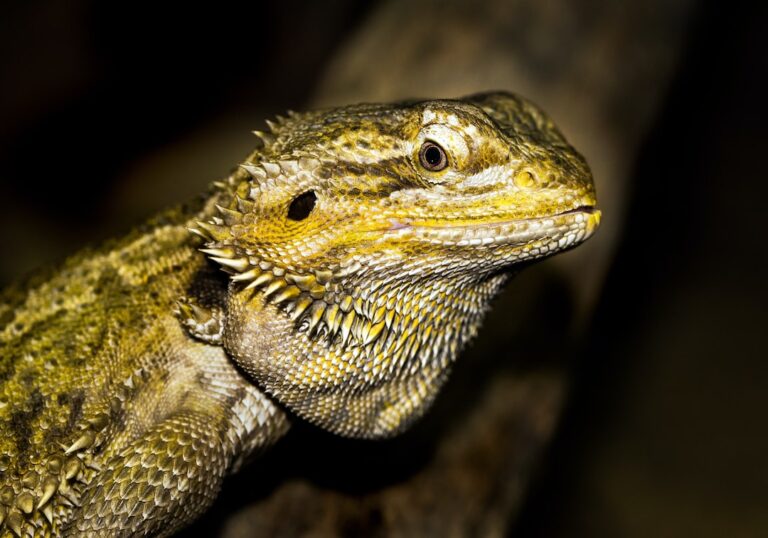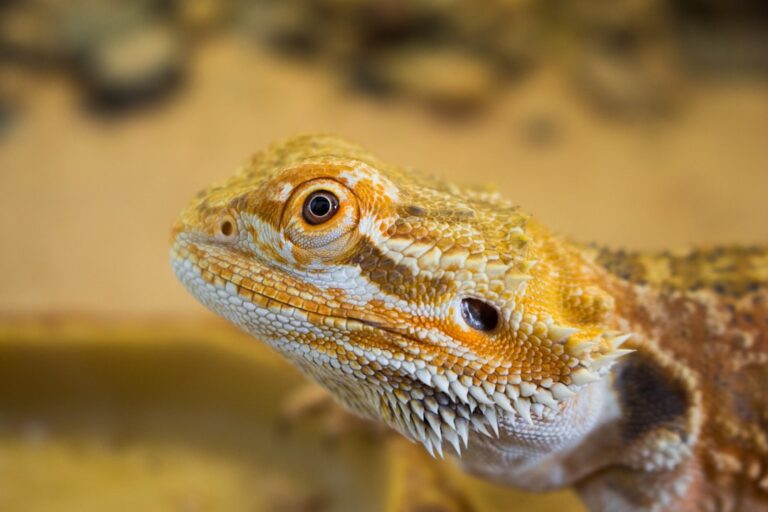The Science Behind Bearded Dragon Ears: What You Need to Know
Table of Contents
Introduction
Understanding the ears of bearded dragons is crucial for their overall health and well-being. The ears play a vital role in their survival, communication, and behavior. By understanding the anatomy, mechanism, and common problems associated with bearded dragon ears, owners can provide better care and prevent potential issues. This article will provide a comprehensive overview of bearded dragon ears, including their anatomy, how they hear, their importance in survival, common ear problems, prevention tips, cleaning instructions, hearing loss management, ear development, the connection between ears and behavior, current research, and the importance of taking care of their ears.
Anatomy of Bearded Dragon Ears: Understanding the Basics
Bearded dragon ears are located on the sides of their heads, just behind their eyes. They are small, round openings covered by a thin layer of skin called the tympanic membrane. The tympanic membrane acts as a protective barrier for the delicate structures inside the ear. Inside the ear, there are three main parts: the outer ear, middle ear, and inner ear.
The outer ear consists of the tympanic membrane and the ear canal. The tympanic membrane vibrates when sound waves hit it, and these vibrations are then transmitted to the middle ear. The middle ear contains three small bones called the ossicles: the malleus, incus, and stapes. These bones amplify the sound vibrations and transmit them to the inner ear. The inner ear is responsible for converting sound vibrations into electrical signals that can be interpreted by the brain.
How Bearded Dragons Hear: The Mechanism Explained
The process of hearing in bearded dragons begins when sound waves enter the ear canal and hit the tympanic membrane. The vibrations of the tympanic membrane are then transmitted to the ossicles in the middle ear. The ossicles amplify the sound vibrations and transmit them to the inner ear.
In the inner ear, there are tiny hair cells called cilia that detect the sound vibrations. When the cilia are stimulated by the vibrations, they send electrical signals to the brain through the auditory nerve. The brain then interprets these signals as sound.
The Importance of Ears for Bearded Dragons: Their Role in Survival
Bearded dragons rely on their ears for survival in the wild. Their ears help them detect potential predators and prey. The ability to hear the sounds of approaching predators allows bearded dragons to take evasive action and avoid being caught. Similarly, the ability to hear the sounds of prey, such as insects or small rodents, helps bearded dragons locate and capture their food.
Ears also play a crucial role in communication among bearded dragons. They use a combination of head movements, body postures, and ear positions to communicate with each other. For example, a bearded dragon may flatten its ears against its head to signal submission or fear, while erect ears may indicate aggression or dominance. By understanding these ear movements, owners can better interpret their bearded dragon’s behavior and respond accordingly.
Common Ear Problems in Bearded Dragons: Symptoms and Treatment
While bearded dragons are generally hardy reptiles, they can still experience ear problems. Some common ear problems in bearded dragons include ear infections, foreign bodies in the ear canal, and ear mites.
Ear infections can occur when bacteria or fungi enter the ear canal and multiply. Symptoms of an ear infection may include redness, swelling, discharge, and a foul odor. Treatment typically involves cleaning the ear and administering antibiotics or antifungal medication as prescribed by a veterinarian.
Foreign bodies, such as debris or insects, can sometimes get lodged in the ear canal. This can cause discomfort and irritation. If a foreign body is suspected, it is important to seek veterinary care to safely remove it.
Ear mites are tiny parasites that can infest the ears of bearded dragons. They can cause itching, redness, and irritation. Treatment typically involves cleaning the ears and administering medication to eliminate the mites.
Bearded Dragon Ear Infections: Causes and Prevention Tips
Ear infections in bearded dragons can be caused by a variety of factors, including poor hygiene, trauma to the ear, or a weakened immune system. It is important to maintain good hygiene by regularly cleaning the ears and keeping the enclosure clean. Avoid using harsh chemicals or abrasive materials when cleaning the ears, as this can cause further damage.
Prevention tips for ear infections include providing a clean and spacious enclosure, maintaining proper humidity levels, and avoiding overcrowding. Regular veterinary check-ups can also help detect and prevent potential ear infections.
How to Clean Bearded Dragon Ears: A Step-by-Step Guide
Cleaning bearded dragon ears is an important part of their overall care. It helps prevent ear infections and keeps their ears healthy. Here is a step-by-step guide on how to clean bearded dragon ears:
1. Prepare the cleaning solution: Mix a small amount of warm water with a gentle reptile-safe cleanser or saline solution. Avoid using harsh chemicals or soaps.
2. Gently restrain the bearded dragon: Hold the bearded dragon securely but gently to prevent any sudden movements.
3. Wet a cotton ball or soft cloth with the cleaning solution: Make sure the cotton ball or cloth is damp, not dripping wet.
4. Gently wipe the outer ear: Use the damp cotton ball or cloth to gently wipe the outer ear, removing any dirt or debris. Be careful not to insert anything into the ear canal.
5. Dry the ear: Use a dry cotton ball or cloth to gently dry the ear. Make sure the ear is completely dry to prevent moisture buildup.
6. Repeat on the other ear: Repeat the cleaning process on the other ear, using a fresh cotton ball or cloth.
7. Monitor for any signs of infection: After cleaning, monitor the bearded dragon’s ears for any signs of infection, such as redness, swelling, or discharge. If any signs are present, seek veterinary care.
Regular ear cleaning should be done as part of a routine care regimen for bearded dragons. It is important to be gentle and avoid causing any discomfort or injury to the ears.
Hearing Loss in Bearded Dragons: Causes and Management
Hearing loss can occur in bearded dragons due to various factors, including age, genetics, trauma, or exposure to loud noises. Signs of hearing loss may include a lack of response to sound, difficulty locating prey, or changes in behavior.
If hearing loss is suspected, it is important to consult with a veterinarian who specializes in reptiles. They can perform a thorough examination and recommend appropriate management strategies. While there is no cure for hearing loss in bearded dragons, management may involve making environmental modifications to accommodate their needs. This can include providing visual cues for feeding, ensuring a safe and secure enclosure, and minimizing exposure to loud noises.
Bearded Dragon Ear Development: What Happens in the First Few Months?
Bearded dragon ears undergo significant development in the first few months of life. When bearded dragons hatch from their eggs, their ears are not fully developed. Over time, the ears will grow and mature, allowing the bearded dragon to hear more effectively.
During this time, it is important to provide a suitable environment for the bearded dragon’s ear development. This includes maintaining proper humidity levels, providing a balanced diet, and ensuring a clean and spacious enclosure. Regular veterinary check-ups can also help monitor the progress of ear development and address any potential issues.
The Connection Between Bearded Dragon Ears and Behavior
Bearded dragon behavior is closely linked to their ears. By observing their ear movements, owners can gain insight into their bearded dragon’s mood and intentions. For example, flattened ears may indicate fear or submission, while erect ears may indicate aggression or dominance.
Bearded dragons also use their ears to communicate with each other. They can make subtle movements with their ears to signal their intentions or establish dominance. By understanding these ear movements, owners can better interpret their bearded dragon’s behavior and respond accordingly.
The Future of Bearded Dragon Ear Research: What Scientists are Studying
While there is still much to learn about bearded dragon ears, scientists are actively studying various aspects of their anatomy, hearing mechanisms, and behavior. Current research focuses on understanding the development of bearded dragon ears, the impact of environmental factors on their hearing, and the connection between ear health and overall well-being.
Future developments in the field may include advancements in diagnostic techniques for ear problems, improved treatment options for ear infections, and a better understanding of the role of ears in bearded dragon behavior. Continued research will contribute to the overall knowledge and care of bearded dragons.
Conclusion
Understanding bearded dragon ears is essential for their overall health and well-being. By understanding their anatomy, mechanism of hearing, and common ear problems, owners can provide better care and prevent potential issues. Regular ear cleaning, monitoring for signs of infection, and seeking veterinary care when needed are crucial for maintaining healthy ears. By taking care of their ears, owners can ensure that their bearded dragons can thrive and communicate effectively.




